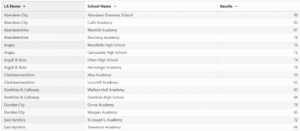
Top 2 Schools in Scotland
The top 2 schools in each local authority are now available to view. Check this page for more details: National 5 exam results https://scottishschoolresults.com/national-5-exam-results/ You

Average National 5 results by Local Authority
East Renfrewshire, East Dunbartonshire and West Lothian have the highest national 5 average results in Scotland. Hover over each bar on the chart to see
Scotland has a distinctive and autonomous educational system that differs from the rest of the United Kingdom. The educational system is characterized by a focus on flexibility, inclusivity, and a distinct curriculum. Here’s an overview of the educational landscape in Scotland:
Early Education:
1. Early Learning and Childcare:
Available for children from the age of 3.
Focuses on play-based learning and development.
Primary Education:
2. Primary School:
Compulsory for children aged 5 to 11.
Curriculum includes English, mathematics, science, social studies, and physical education.
Emphasis on the development of literacy and numeracy skills.
Secondary Education:
3. Secondary School:
Compulsory for students aged 12 to 16.
Students typically take the Scottish Qualifications Authority (SQA) National Qualifications, including National 4 and National 5 exams.
A broad curriculum that allows students to explore a range of subjects.
4. Senior Phase:
Ages 16 to 18.
Students can choose between academic qualifications (Highers and Advanced Highers) or vocational qualifications (Scottish Vocational Qualifications – SVQs).
Tertiary Education:
5. Colleges:
Offer a variety of vocational and academic courses.
Provide pathways to higher education or employment.
6. Universities:
Scotland is home to several universities, including the University of Edinburgh, the University of Glasgow, and the University of St. Andrews.
Offer undergraduate and postgraduate degrees across various disciplines.
Assessment and Qualifications:
7. Scottish Qualifications Authority (SQA):
Responsible for the development, accreditation, assessment, and certification of qualifications.
Qualifications include Standard Grades, Highers, and Advanced Highers.
Languages:
8. Gaelic Medium Education:
Some schools provide education primarily in the Scottish Gaelic language, reflecting Scotland’s linguistic diversity.
Unique Features:
9. Curriculum for Excellence (CfE):
Introduced in 2010, CfE aims to provide a broad and flexible curriculum focused on the holistic development of students.
Encourages interdisciplinary learning and the development of skills alongside knowledge.
10. No Tuition Fees for Scottish Students:
Scottish students attending universities in Scotland do not pay tuition fees for their first degree.
Challenges and Innovations:
11. Challenges:
Educational inequalities.
Addressing the impact of socio-economic factors on educational outcomes.
12. Innovations:
Continued emphasis on the CfE and adaptability of the educational system.
Efforts to increase access to tertiary education through various support programs.
The educational system in Scotland is shaped by a commitment to providing a broad and inclusive education, with a focus on individualized learning and the development of a skilled and knowledgeable citizenry. Ongoing efforts seek to address challenges and further enhance the quality of education in the country.